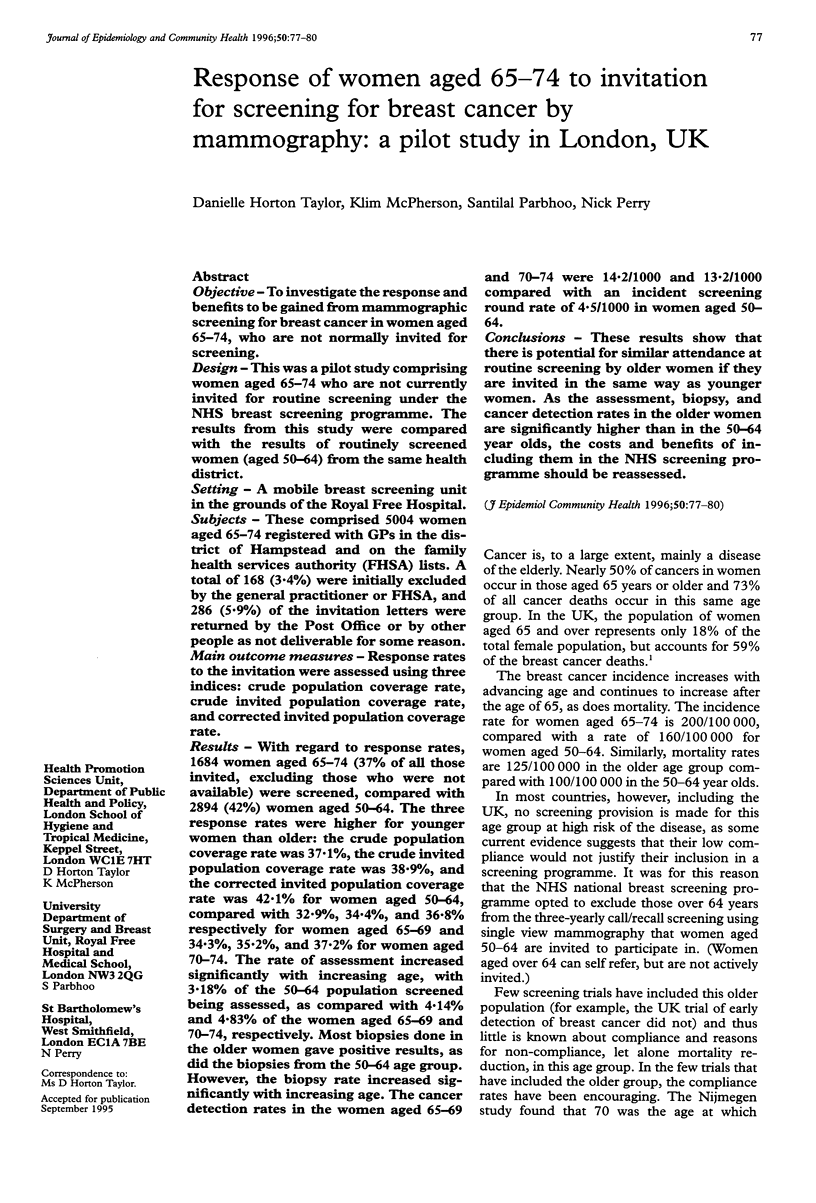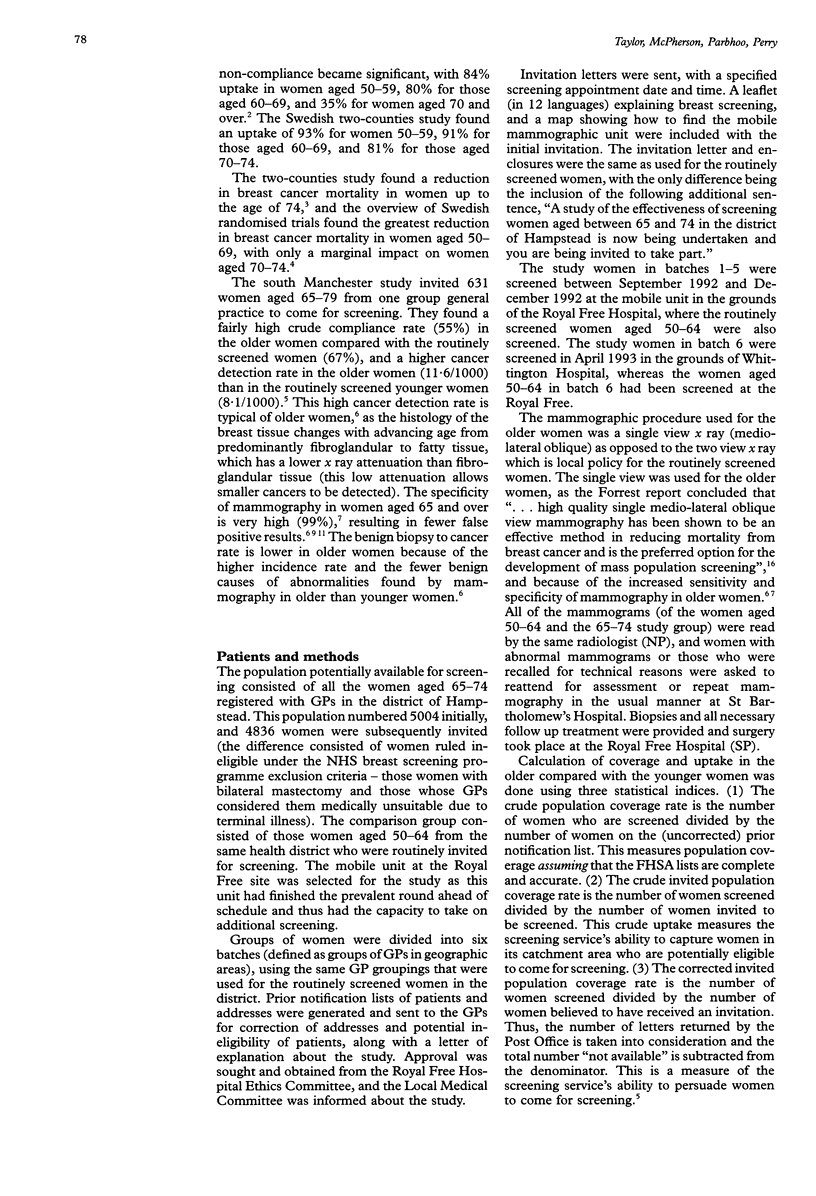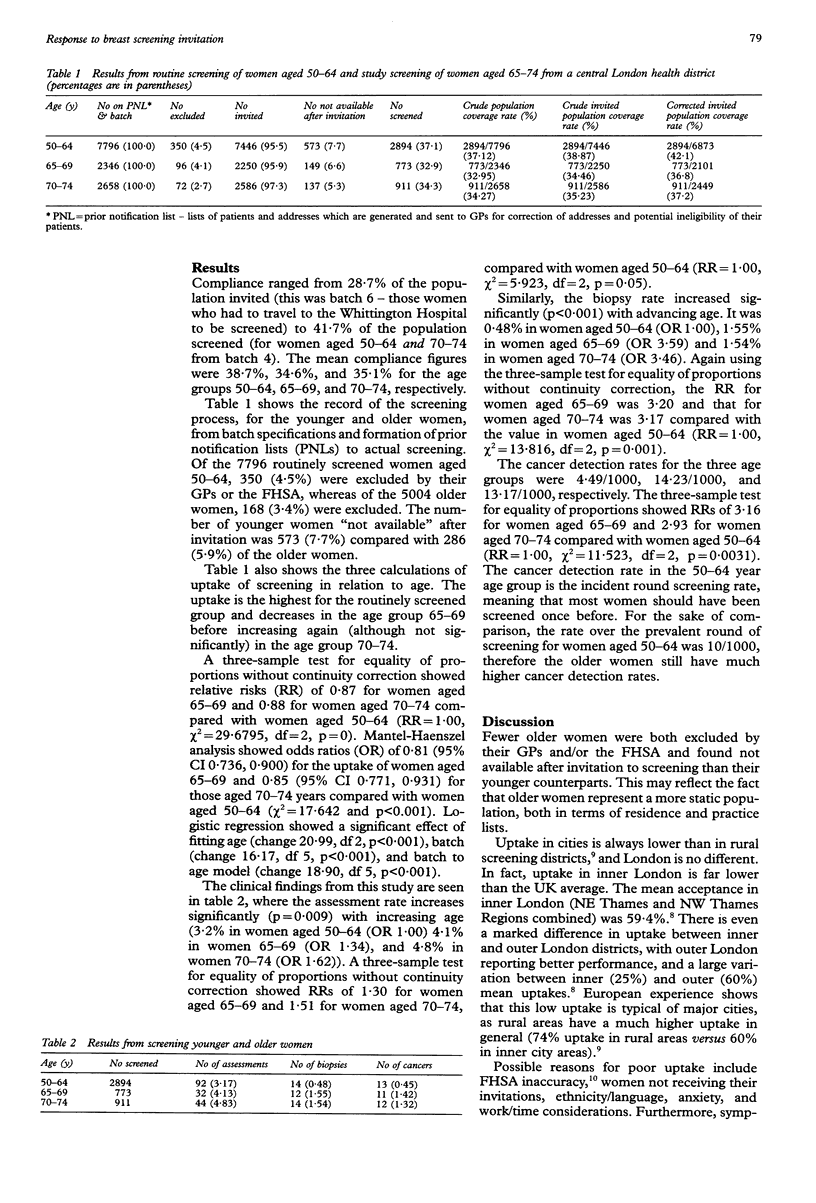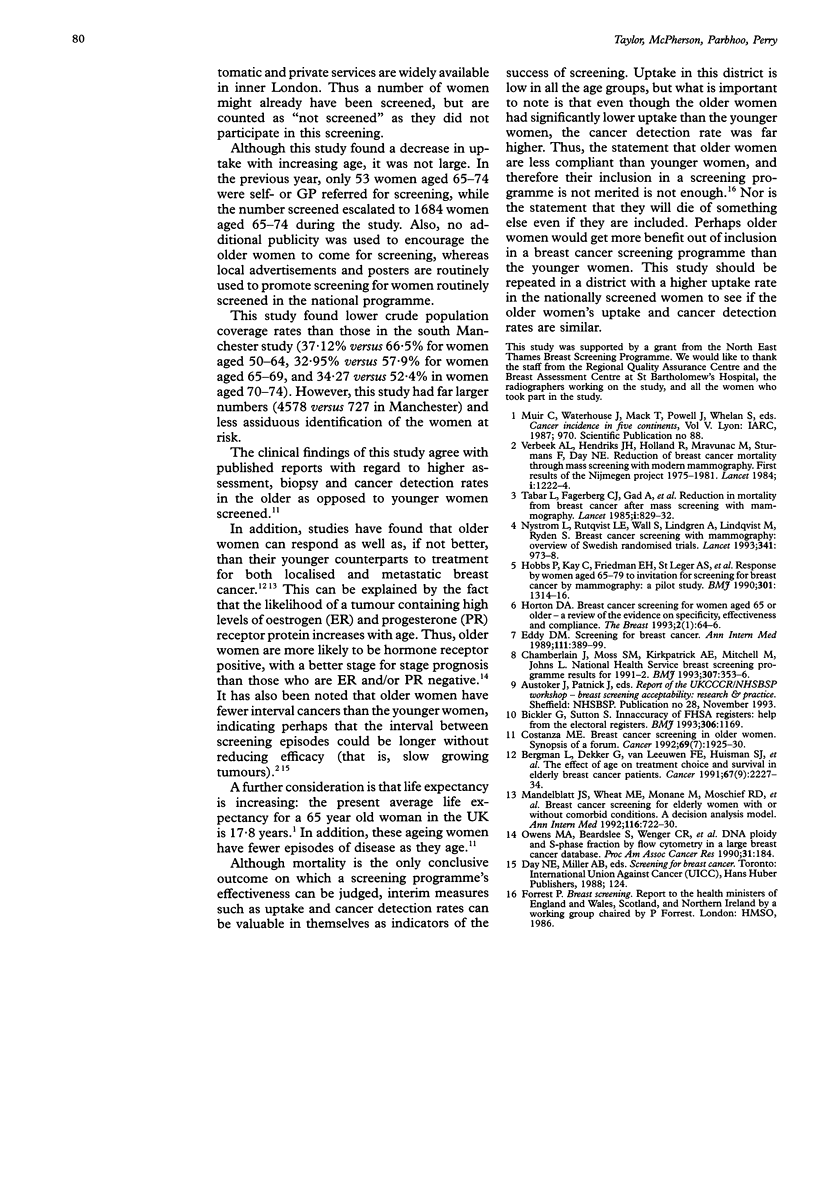Abstract
OBJECTIVE: To investigate the response and benefits to be gained from mammographic screening for breast cancer in women aged 65-74, who are not normally invited for screening. DESIGN: This was a pilot study comprising women aged 65-74 who are not currently invited for routine screening under the NHS breast screening programme. The results from this study were compared with the results of routinely screened women (aged 50-64) from the same health district. SETTING: A mobile breast screening unit in the grounds of the Royal Free Hospital. SUBJECTS: These comprised 5004 women aged 65-74 registered with GPs in the district of Hampstead and on the family health services authority (FHSA) lists. A total of 168 (3.4%) were initially excluded by the general practitioner or FHSA, and 286 (5.9%) of the invitation letters were returned by the Post Office or by other people as not deliverable for some reason. MAIN OUTCOME MEASURES: Response rates to the invitation were assessed using three indices: crude population coverage rate, crude invited population coverage rate, and corrected invited population coverage rate. RESULTS: With regard to response rates, 1684 women aged 65-74 (37% of all those invited, excluding those who were not available) were screened, compared with 2894 (42%) women aged 50-64. The three response rates were higher for younger women than older: the crude population coverage rate was 37.1%, the crude invited population coverage rate was 38.9%, and the corrected invited population coverage rate was 42.1% for women aged 50-64, compared with 32.9%, 34.4%, and 36.8% respectively for women aged 65-69 and 34.3%, 35.2%, and 37.2% for women aged 70-74. The rate of assessment increased significantly with increasing age, with 3.18% of the 50-64 population screened being assessed, as compared with 4.14% and 4.83% of the women aged 65-69 and 70-74, respectively. Most biopsies done in the older women gave positive results, as did the biopsies from the 50-64 age group. However, the biopsy rate increased significantly with increasing age. The cancer detection rates in the women aged 65-69 and 70-74 were 14.2/1000 and 13.2/1000 compared with an incident screening round rate of 4.5/1000 in women aged 50-64. CONCLUSIONS: These results show that there is potential for similar attendance at routine screening by older women if they are invited in the same way as younger women. As the assessment, biopsy, and cancer detection rates in the older women are significantly higher than in the 50-64 year olds, the costs and benefits of including them in the NHS screening programme should be reassessed.
Full text
PDF



Selected References
These references are in PubMed. This may not be the complete list of references from this article.
- Bergman L., Dekker G., van Leeuwen F. E., Huisman S. J., van Dam F. S., van Dongen J. A. The effect of age on treatment choice and survival in elderly breast cancer patients. Cancer. 1991 May 1;67(9):2227–2234. doi: 10.1002/1097-0142(19910501)67:9<2227::aid-cncr2820670903>3.0.co;2-0. [DOI] [PubMed] [Google Scholar]
- Chamberlain J., Moss S. M., Kirkpatrick A. E., Michell M., Johns L. National Health Service breast screening programme results for 1991-2. BMJ. 1993 Aug 7;307(6900):353–356. doi: 10.1136/bmj.307.6900.353. [DOI] [PMC free article] [PubMed] [Google Scholar]
- Costanza M. E. Breast cancer screening in older women. Synopsis of a forum. Cancer. 1992 Apr 1;69(7 Suppl):1925–1931. doi: 10.1002/1097-0142(19920401)69:7+<1925::aid-cncr2820691709>3.0.co;2-u. [DOI] [PubMed] [Google Scholar]
- Eddy D. M. Screening for breast cancer. Ann Intern Med. 1989 Sep 1;111(5):389–399. doi: 10.7326/0003-4819-111-5-389. [DOI] [PubMed] [Google Scholar]
- Hobbs P., Kay C., Friedman E. H., St Leger A. S., Lambert C., Boggis C. R., Howard T. M., Owen A. W., Asbury D. L. Response by women aged 65-79 to invitation for screening for breast cancer by mammography: a pilot study. BMJ. 1990 Dec 8;301(6764):1314–1316. doi: 10.1136/bmj.301.6764.1314. [DOI] [PMC free article] [PubMed] [Google Scholar]
- Mandelblatt J. S., Wheat M. E., Monane M., Moshief R. D., Hollenberg J. P., Tang J. Breast cancer screening for elderly women with and without comorbid conditions. A decision analysis model. Ann Intern Med. 1992 May 1;116(9):722–730. doi: 10.7326/0003-4819-116-9-722. [DOI] [PubMed] [Google Scholar]
- Nyström L., Rutqvist L. E., Wall S., Lindgren A., Lindqvist M., Rydén S., Andersson I., Bjurstam N., Fagerberg G., Frisell J. Breast cancer screening with mammography: overview of Swedish randomised trials. Lancet. 1993 Apr 17;341(8851):973–978. doi: 10.1016/0140-6736(93)91067-v. [DOI] [PubMed] [Google Scholar]
- Tabár L., Fagerberg C. J., Gad A., Baldetorp L., Holmberg L. H., Gröntoft O., Ljungquist U., Lundström B., Månson J. C., Eklund G. Reduction in mortality from breast cancer after mass screening with mammography. Randomised trial from the Breast Cancer Screening Working Group of the Swedish National Board of Health and Welfare. Lancet. 1985 Apr 13;1(8433):829–832. doi: 10.1016/s0140-6736(85)92204-4. [DOI] [PubMed] [Google Scholar]
- Verbeek A. L., Hendriks J. H., Holland R., Mravunac M., Sturmans F., Day N. E. Reduction of breast cancer mortality through mass screening with modern mammography. First results of the Nijmegen project, 1975-1981. Lancet. 1984 Jun 2;1(8388):1222–1224. doi: 10.1016/s0140-6736(84)91703-3. [DOI] [PubMed] [Google Scholar]


